
archives for 05/2016
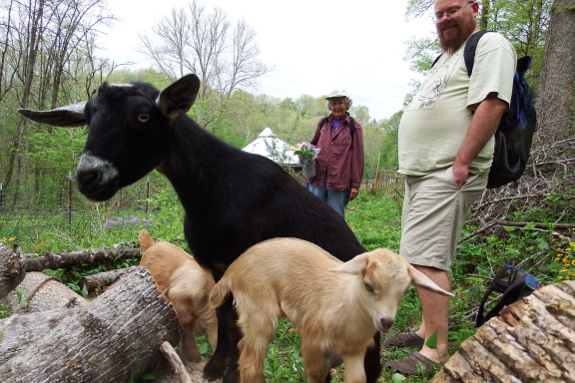
I'm starting to realize
that kidding season is similar to strawberry season --- our impassable
floodplain suddenly doesn't seem so difficult for visitors. Which is
great since I hate to leave the farm and love seeing family and friends.
Thanks for coming, Joey and Mom!

We've hit a dead end on our quest to buy
a monorail.
The nice guy at the Japanese
factory stopped returning our emails.
We might need to plan a trip
to Japan to make it happen?
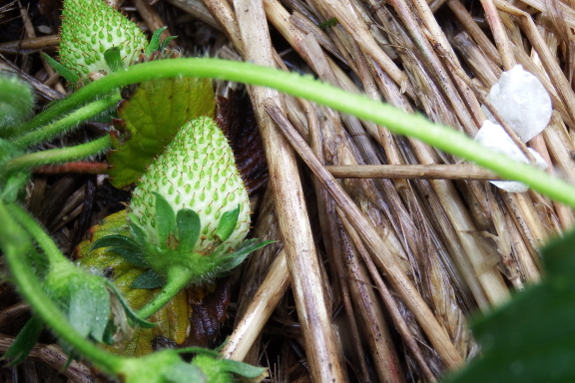
Sometimes, I think I get
more of a kick out of anticipating coming attractions than I do out of
eating the actual fruits. Then I remember the glories of strawberry
season, sitting in the grassy aisles and gorging on drip-down-your-chin
juices. Nope --- consuming the real fruit is even better than eating the
developing berries with my eyes.
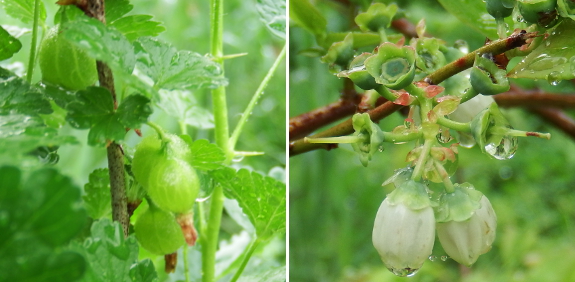
But this is eye-candy season only, so I thought I'd share the joy. In addition to the baby apples I posted about last week, there are scads of berries beginning to bulk up on the 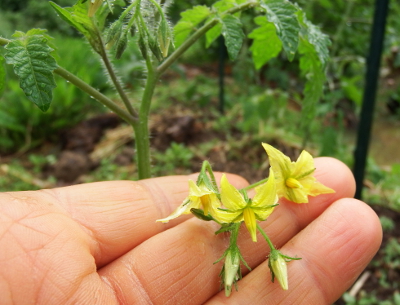 vine. Our dependable gooseberries
and northern highbush blueberries chug along with no help from me, and
the equally dependable raspberries are getting ready to bloom.
vine. Our dependable gooseberries
and northern highbush blueberries chug along with no help from me, and
the equally dependable raspberries are getting ready to bloom.
And, even though it's not really a fruit (unless you want to put
cucumbers and butternut squash in that category), our first tomato is
blooming too. So many joys ahead in this gardening season!
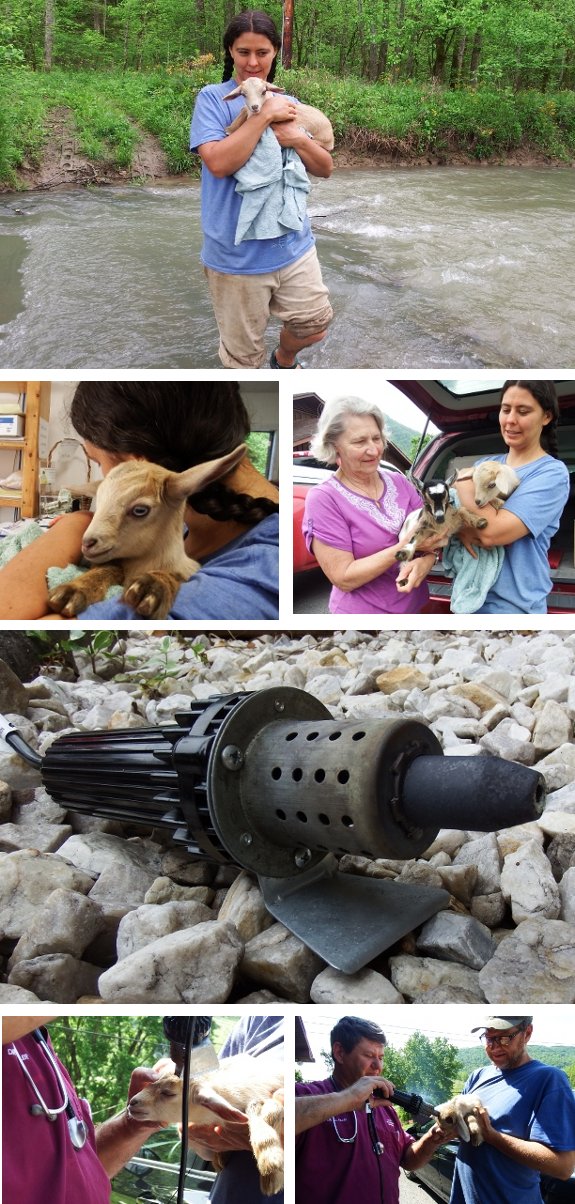
Today was the day Aurora
was old enough for disbudding.
Dr Fuller in
Gate City was so gentle
our little goat barely let out a whimper.
We were very impressed with
Dr Fuller's style and operation.
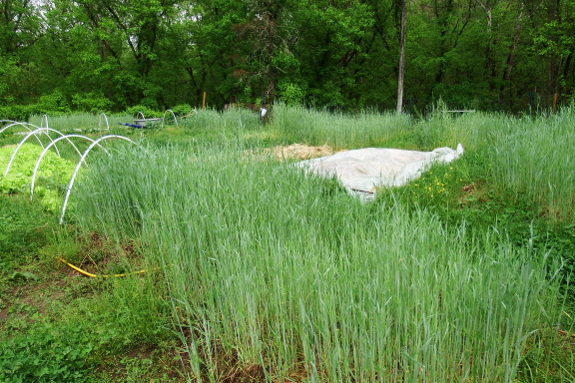
This is the time of year
when the weeds sometimes begin to feel overwhelming. It suddenly began
to rain at the same time I started turning my energy to summer
planting...and the result was an explosion of green in all the wrong
places.
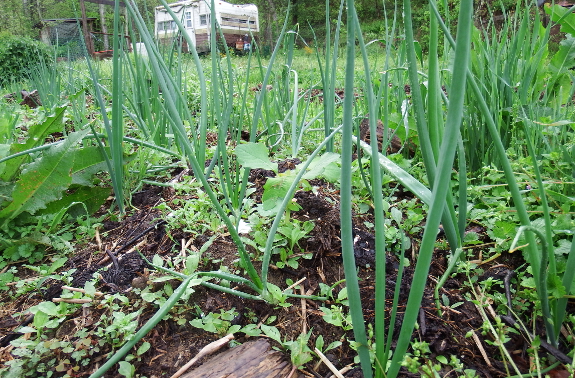
The photo above shows
normal weeding pressure around here. I set out these onions five weeks
ago, and they could definitely use a weed and mulch. But they'll be okay
for another week or two until I get around to them. (Fertility source:
chicken bedding.)
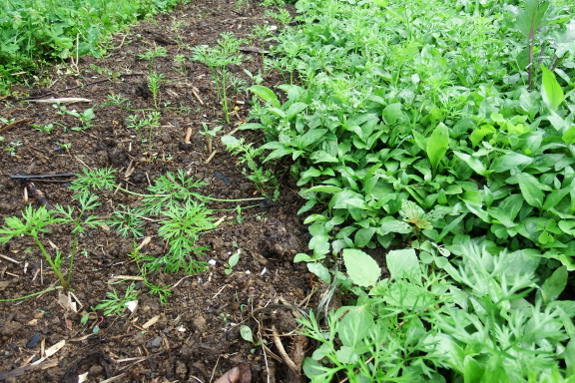
This carrot bed, on the
other hand, is what I think of as a weeding disaster. My homegrown
compost was a little weedier than I would have liked this year, but it
didn't cause much trouble elsewhere. Amid the slow-growing carrots,
though, the weeds are terrible.
Some people would just
give up on the crop, but I'll relentlessly handweed for a few hours
until it's back into shape. After all, there's no way to go back in time
and replant the spring carrots if I throw in the towel now. Still, next
year I'll try to be smarter and plant my carrots in completely
weed-free ground. Maybe Fortier's occultation would be a good trick to try for these very slow-growers.
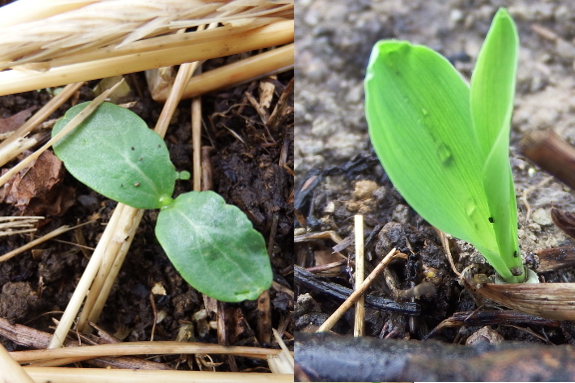
Look who's awake! Corn, beans, and cucumbers are up and running a little early this year.
...Just in time for blackberry winter to come calling. Will a 43-degree
forecast turn into a light freeze that nips all and sundry? I'd like to
say no, but we'll still spend the day covering everything up anyway.
Aurora has bounced back from her disbudding thanks to some TLC from Artemesia.
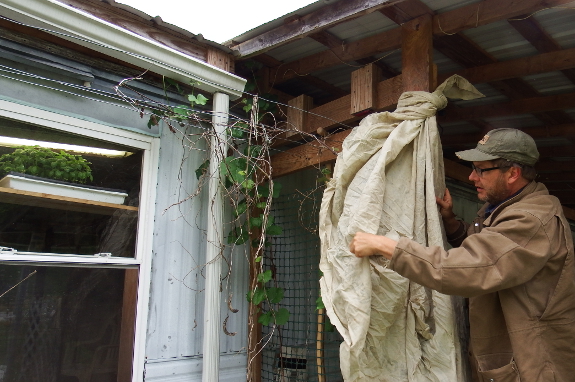
Mark has a very gentle
touch that makes him the right choice for protecting tender spring
growth from late freezes. He wrapped both young grapevines in front of
our trailer in preparation for the cold spell, covering up all of the
stems that have flower buds attached. Fingers crossed the plants inside
those bundles will make it through Blackberry Winter unscathed.
We built a 2x4 grape arbor today to help elevate our vines to avoid any blight.
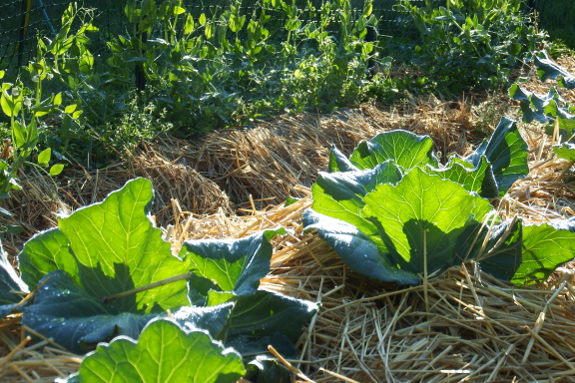
The morning glow was so
beautiful Thursday that I had to pause in my chores to rush and get the
camera. I was glad I did since the light was fleeting and rain had
returned an hour later.
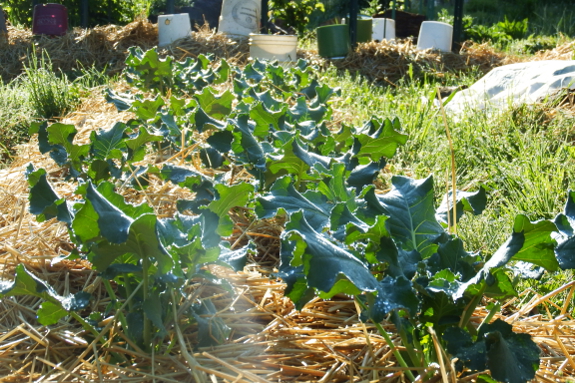
I'm thrilled with my spring cabbage and broccoli this year. Starting the seedlings inside with heating pads and lights
got them out in the soil extra early (under row covers). The result is
big beautiful plants before the cabbageworms have even been spotted.
These broccoli will likely start heading up any week now.
(In case you're curious, the bucket brigade in the background is providing frost protection for our tender tomatoes.)
We threaded the heavy wire
through a series of holes.
I added a middle support to prevent sagging.
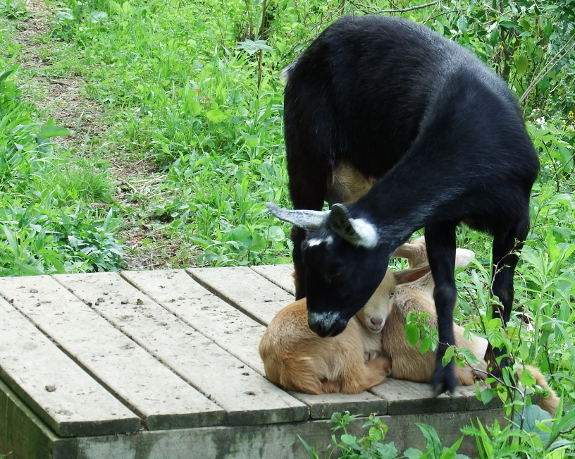
I know most of you want to see cute kid photos like the one above. But what I've really been aching for all week is this:
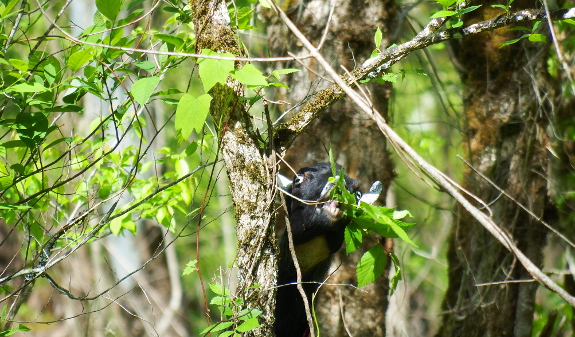
Poor Artemesia is a
helicopter mother who won't eat when she could be taking care of her
kids. And I'll admit I'm a helicopter mother too --- I fuss over our
doe's dietary intake (or lack thereof) like crazy.
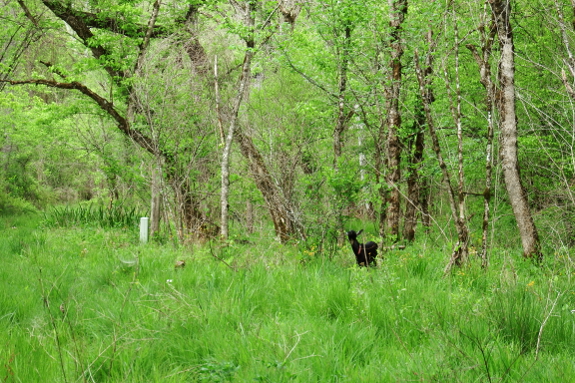
Slowly but surely,
though, we're learning how to get our mama goat to eat. Best option ---
shut the kids in the coop and drag Artemesia down to the floodplain on a
leash. She'll cry for a few minutes, then she seems to forget her
offspring and settles down to the important task of filling her belly.
The twins are always just fine when we return.
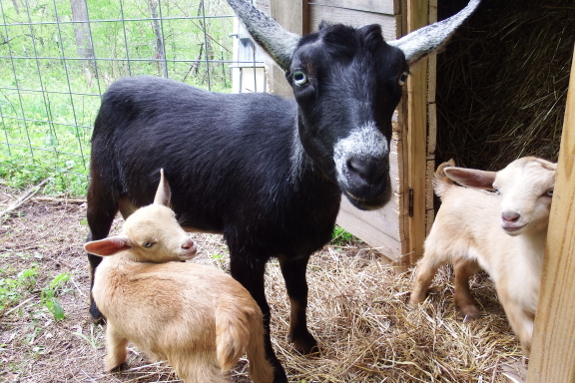
Second-best option: cut some boot-stage grain plants
and drop them off in her manger...then babysit the kids while Artemesia
chows down. I've learned the hard way that just dumping the grub and
running does no good. But if you stick the buckling in the crook of one
arm and then pet Aurora into submission, Artemesia will actually eat.
And, yes, I've also been
easing our doe onto a bit of grain as well. As much as I hate to do it, I
know she needs to keep her calorie count up to feed those high-octane
goat babies. Grain goes down the gullet fast enough that she can
actually grab a few bites in between kid wrangling. Hopefully in a few
more weeks, she'll ease off on her overprotectiveness and the whole
family can go out to enjoy dinner on the green.
We had a nice day today taking in an educational workshop on sheep and goats.
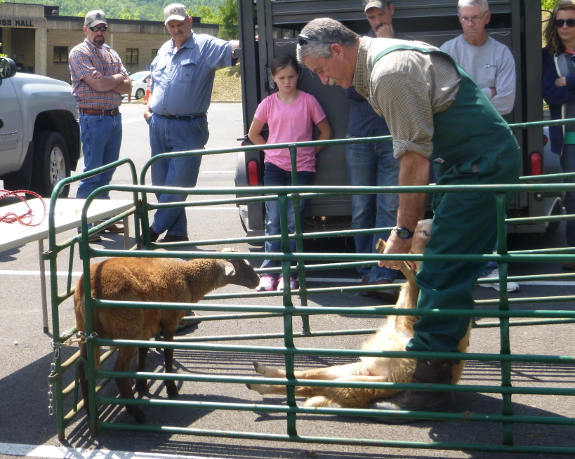
If you ever get a chance to attend an Extension Service Master Shepherd Course,
I highly recommend it. We only took in one of the two days because
Artemesia was kidding the weekend of the other, but hopefully we'll get a
second stab at the earlier session next year. In the meantime, I came
home with so many notes that it will probably take me several days to
work through all of the information.
The morning classes at the event we attended were led by Dr. Roberson of LMU-Veterinary College.
Despite showing us lots of scary photos that will probably keep me up
at night, the excellent teacher's two-hour time slot flew by.
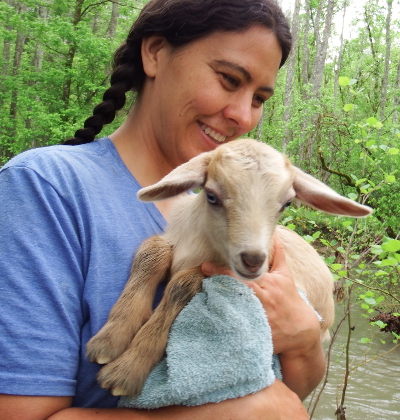 The
information most relevant to our farm was his vaccination
recommendations. Basically, he suggests only preemptively treating for
diseases that have shown up on your farm in the past. That said,
Roberson is a fan of the CD&T (Clostridium perfreingens type C and D plus tetanus) vaccine.
The
information most relevant to our farm was his vaccination
recommendations. Basically, he suggests only preemptively treating for
diseases that have shown up on your farm in the past. That said,
Roberson is a fan of the CD&T (Clostridium perfreingens type C and D plus tetanus) vaccine.
We didn't mean too, but
accidentally got the first dose of that vaccination for Aurora while we
were at the vet's office last Monday, so I'm glad to hear it's a
recommended treatment. Tetanus is most common in young goats and sheep
that have been subjected to castration, tail docking, or disbudding, while the other half of the vaccine will help prevent so-called "overeating disease" primarily in grain-fed animals.
I'll probably do a bit
more research on the topic (and will be curious to hear what readers
have to say on the subject). But Dr. Roberson's advice does suggest that
we should plan to bring Aurora in for the recommended booster shot in a
few weeks. By that time, Aurora may be almost too big to carry at the
rate she's growing!
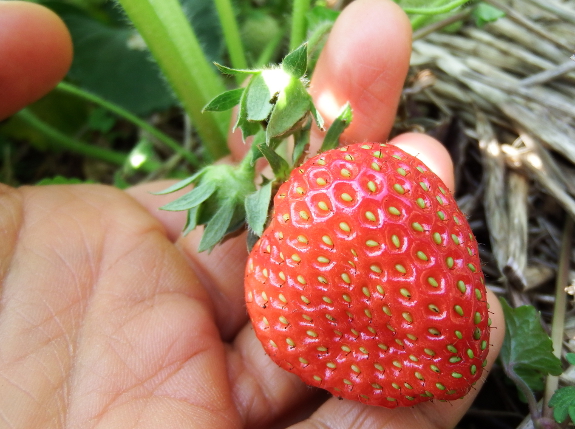
The big question is: who will ripen first? Honeoye or Galleta?
Honeyoye won by a nose because the earliest Galletta flowers got frost-nipped.
 Today's
the big day --- the third book in my soil series is live and the fourth
book is up for preorder (and on sale for a limited time)! I hope you'll
take a chance on a series that has been described as "Easy, useful, and
homestead tested."
Today's
the big day --- the third book in my soil series is live and the fourth
book is up for preorder (and on sale for a limited time)! I hope you'll
take a chance on a series that has been described as "Easy, useful, and
homestead tested."
Yes, the topic is a bit geeky and semi-scientific. But paying attention
to your soil will pay huge dividends in the quality of your crops and
the ease of your gardening endeavors now and for a years into the
future.
Without further ado, here are the links to book 3, Balancing Soil Nutrients and Acidity:
And here are the links to book 4, Soil Amendments for the Organic Garden:

As you may recall, these are quarters of my upcoming print book, The Ultimate Guide to Soil,
and I have to admit I went over my word-count quota by the time I
finished part three. I actually considered pulling part four out to be
its own print book since that section is quite a tome, full of all of
the tips and tricks I've found for incorporating both found and
purchased amendments (biochar, humanure, black soldier fly larvae, and
much more) into a beyond-organic garden. But I eventually talked my
editor into letting me fold it into the print book without cutting
anything out.
Why am I telling you all
that? Because I had to be a bit evasive to keep my promise of offering
new books at 99 cents for a couple of days during preorder when it came
to Soil Amendments for the Organic Garden.
Book four is so big that Amazon told me the minimum price I could apply
to the book was $1.99...so I uploaded a fake file. You won't get that
fake since I'll swap it out for the real book as soon as I raise the
price later in the week. But I won't ever be able to offer Soil Amendments for the Organic Garden
below $1.99 in the future. (Fake files only work during preorder.) So
if you want the gargantuan last quarter really cheap, snag it now.
Thanks so much for
reading! And if you enjoy my ebooks, I hope you'll consider taking the
time to write a brief review. Your social proof helps strangers decide
to take a chance on a new author and gives me the leisure to share my
experiences with you every day on the blog. I appreciate having you
along for the ride!
This is the week we will
start locking the kids in the kidding
stall at night.
An extra latch at the bottom
should stop any wiggle throughs.
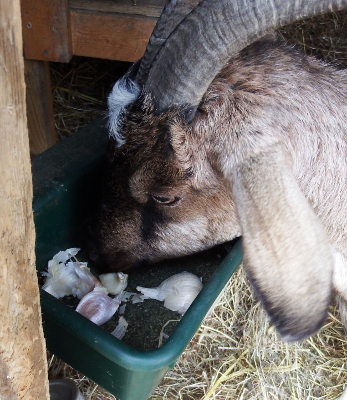 The afternoon session of the Master Shepherd course we attended was
led by Dahlia O'Brien and covered sheep and goat parasite management
from a scientific perspective. Predictably, there was a lot of talk of
chemical dewormers, but the most valuable section to me was her input on
less mainstream techniques for keeping parasite loads low in your
caprine and ovine herds.
The afternoon session of the Master Shepherd course we attended was
led by Dahlia O'Brien and covered sheep and goat parasite management
from a scientific perspective. Predictably, there was a lot of talk of
chemical dewormers, but the most valuable section to me was her input on
less mainstream techniques for keeping parasite loads low in your
caprine and ovine herds.
I didn't take many notes
on the management section since this is all data the biological farmer
likely has under her belt (whether or not she's able to implement it on
her own farm). Don't overstock. Do keep your animals healthy by feeding
them appropriately. Don't let your animals eat or drink poop. Don't
graze pasture plants closer than two inches to the ground. Try to rotate
pastures in such a way that you keep parasite loads low (moving animals
after four or five days on pasture and not returning them to the same
spot for sixty days).
More interesting to me
was Dr. O'Brien's take on which herbal and non-mainstream dewormers
work. Basically, she said there's no scientific data that garlic,
papaya, pumpkin seeds, ginger, wormwood, fennel, purchased herbal
mixtures, or diatomaceous earth work at controlling goat and sheep
intestinal parasites. She admitted that the herbs may help boost animal
immune systems so they can better fight off the invaders, but she
doesn't recommend counting on herbs as a first or even second line of
defense. (Diatomaceous earth didn't even make the cut for the
overall-health-improvement category --- it's only been shown to work as
an insecticide.)
On the other hand, O'Brien wasn't all chemicals all the way. Instead, she recommended copper oxide wire particles (COWP or copper boluses),
which she says are much safer than copper sulfate and which studies
have suggested have a significant impact on lowering loads of barberpole
worms. She recommends treating goat kids at weaning age (which is a
dangerous time for worm infestations) with 0.5 grams and treating
older animals up to four times per grazing season with 1 to 2 grams.
Never treat more often than once every six weeks, and assess your area's
soil copper levels before treating sheep.
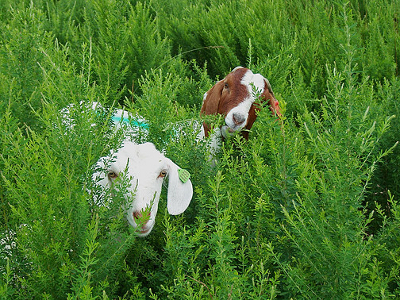 Another
supplement that has been scientifically tested and proven to reduce
parasite levels in goats and sheep is the condensed tannins found in
lespedeza clover (Sericea lespedeza).
Forage chicory has also been reported to contain similar condensed
tannins that have reduced parasite problems in one trial with lambs.
We'll definitely be looking for seeds to incorporate these plants into
our pastures and surrounding areas in the near future.
Another
supplement that has been scientifically tested and proven to reduce
parasite levels in goats and sheep is the condensed tannins found in
lespedeza clover (Sericea lespedeza).
Forage chicory has also been reported to contain similar condensed
tannins that have reduced parasite problems in one trial with lambs.
We'll definitely be looking for seeds to incorporate these plants into
our pastures and surrounding areas in the near future.
Want more info on non-chemical goat and sheep parasite control? Wormx.info won Dr. O'Brien's seal of approval for containing tried and true information. The site is also, non-coincidentally, the source of the second photo in this post.
You can't find these
doohickeys online....I looked and looked.
Our local stihl guy at the
Gate City feed store had a big jar of them.
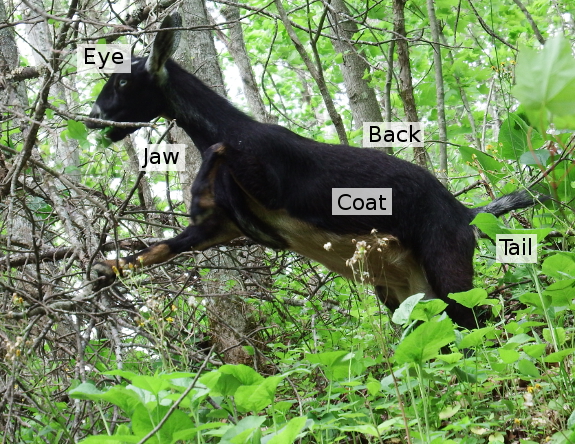
I've been playing around with fecal egg counts to keep a handle on parasite loads on our farm. But Dr. Dahlia O'Brien
doesn't actually recommend egg counts in that scenario. Instead, she
thinks the tests are most handy for determining contamination levels of
pastures (rather than animals), for telling which parasite species are
in your herd and which drugs those worms are resistant to, and for
determining which animals to cull (those with high parasite loads that
seem healthy and thus are spreading the worms to the less resilient
animals).
What should you use
instead to keep an eye on individual animals and determine if they need
to be dewormed? The five-point check is a quick and easy technique that
can be used on goats or sheep to eyeball their parasite levels in a
minute or less. Start by using the FAMACHA method (more on that in a
moment) to assess anemia due to barberpole worms via the color inside
the animal's eyelids. Next feel along the animal's back to get a body-condition score
--- low fat equates to general ill health (or not enough food in heavy
producing animals). Check under the tail for scouring (diarrhea), which
is a sign of coccidia infestation (a non-worm internal parasite that can
do a number on animals' intestines). Look for bottle jaw (a swollen
jaw), which is an extreme sign of parasite infestation. Then check the
nose for discharge (in sheep) or check the coat quality (in goats) as
another overall health indicator.
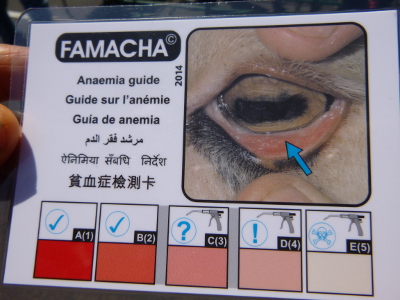 I
suspect many of you use the five-point check (or parts of it) without
even noticing. Of course you'll pay attention to a goat with a scruffy
coat or a sheep with a daggy bum (as they say Down Under). Once you
learn where your animals hold their excess fat, you've probably gotten
into the habit (like I have) of feeling for fat every time you pet the little spoiled darlings handle those important farm livestock. Only the FAMACHA test really requires additional explanation.
I
suspect many of you use the five-point check (or parts of it) without
even noticing. Of course you'll pay attention to a goat with a scruffy
coat or a sheep with a daggy bum (as they say Down Under). Once you
learn where your animals hold their excess fat, you've probably gotten
into the habit (like I have) of feeling for fat every time you pet the little spoiled darlings handle those important farm livestock. Only the FAMACHA test really requires additional explanation.
And, unfortunately, that
explanation is pretty intense. In order to become a card-carrying
FAMACHA expert, you have to attend a full-day workshop about that topic
alone or take this online course complete with video test. I'll bet you know what's next on my educational agenda....
The Lunchbox
Pepper plants couldn't wait another day inside.
Thanks to this big head start
this might be a high yield year for these sweet treats.
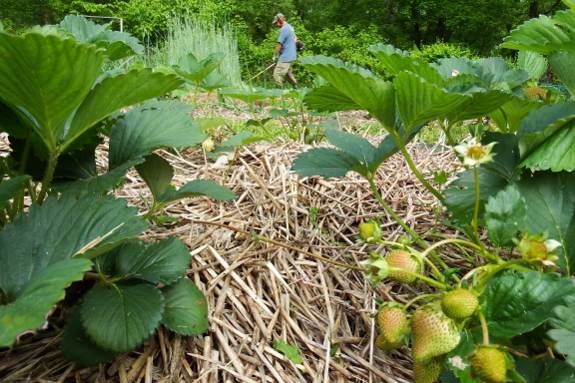
Despite all of the recent
talk about goats, I've been spending most of my outdoor time this month
in the garden. I've planted, weeded, mulched...and got our cover crops
in order.
If you have overwintering grain cover crops (like oats, rye, and barley), now's the time to keep an eye out for the stamens that mean your plants are in full bloom.
Cutting close to the ground at bloom time kills the grains, then you
can plant veggies into the stubble after letting the roots decay for a
couple of weeks. In the meantime, gather up the tops and use them as a
mulch elsewhere...just be aware that the stems dry down much smaller
than you'd expect, so a layer of wet newspaper underneath is a good
idea.
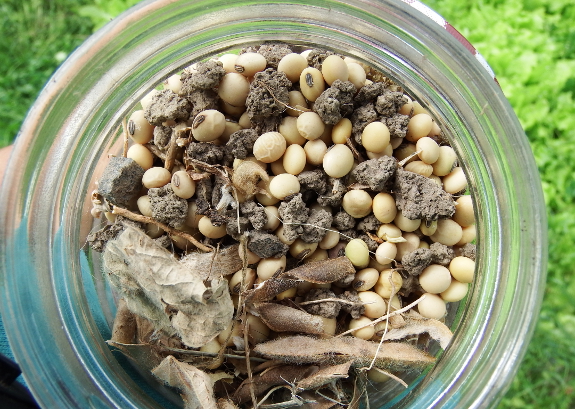
What type of cover crop
do I recommend using to fill in the summer gaps? Buckwheat is my
all-time favorite for fallow areas that you want to put back into
production in another month or so. But last year I fell in love with
soybeans...so much so that I harvested about half a gallon of seeds
to fill this year's garden gaps. Soybeans are a slower crop than
buckwheat and produce less biomass, but they fix nitrogen out of the air
and provide partial fertility for the succeeding crop. As a result, I'm
focusing my soybean plantings in areas where I want to grow fall
brassicas and in new beds that need some nitrogen top-up before being
used for an edible crop.
For more tips on keeping nutrients cycling and organic matter burgeoning with cover crops, check out my primer Homegrown Humus.
I focus on the species that are so easy to grow nobody can mess them
up...and many attract pollinators or make food for you in the process.
How could you go wrong?
We saw our first cabbage worm
of the year this week.
The Broccoli yield might be
higher this year thanks to a big indoor head start.
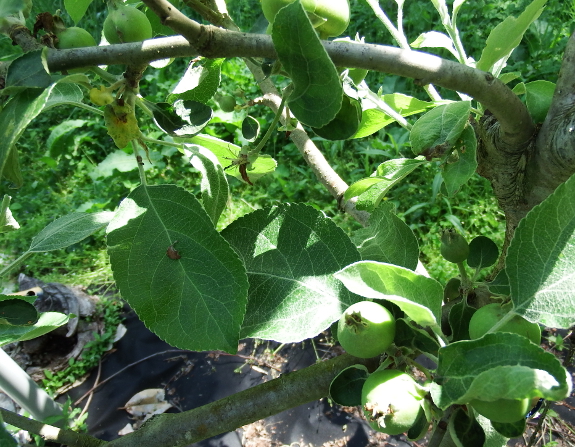
I really didn't expect to
have to thin, but two of our apple trees (Enterprise and Early
Transparent) set such a substantial crop this spring that they required a
little TLC. And even a few of the other trees have pairs of apples in
excessively close proximity despite a hard April freeze having nipped
90% of their crop. Time to thin!
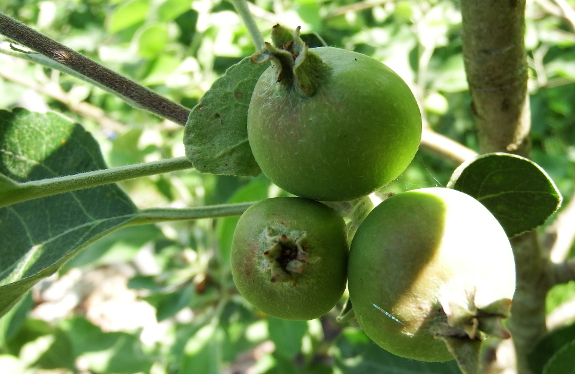
"Why thin?" some of you
are saying. "Don't you want as many apples as you can get?" There are
all kinds of reasons to thin but they tend to come down to size, flavor,
future yield, and disease/pest resistance. Basically, if you don't
thin a tree that is loaded with potential fruits, it'll make lots of
small apples that are more likely to get sick by trapping moisture
between the fruits. And some apple species tend toward biennial bearing,
skipping a year after fruiting heavily the season before.
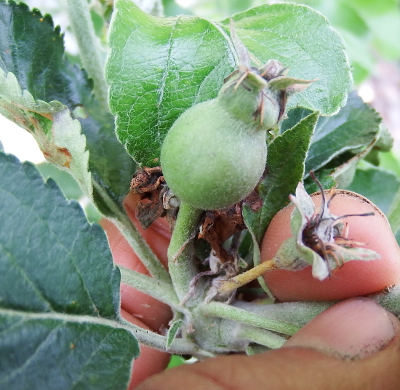 You
can work around all of those issues pretty simply by going in at this
time of year and pinching off excess fruits that set in the same
cluster. Don't be too precipitate about this --- the image on the left
shows a cluster that is self-thinning and you should definitely wait
until the tree has decided which ovaries to abort before removing yet
others. On the other hand, if you wait too late (which one study I read
said was June), the tree will assume it's going to have to ripen all of
those fruits and will decrease it's production of bloom buds for next
year accordingly.
You
can work around all of those issues pretty simply by going in at this
time of year and pinching off excess fruits that set in the same
cluster. Don't be too precipitate about this --- the image on the left
shows a cluster that is self-thinning and you should definitely wait
until the tree has decided which ovaries to abort before removing yet
others. On the other hand, if you wait too late (which one study I read
said was June), the tree will assume it's going to have to ripen all of
those fruits and will decrease it's production of bloom buds for next
year accordingly.
My other caution is to
pinch off the fruits rather than breaking off the whole spur since
apples fruit from the same spot year after year. A lost spur is a lost
apple next year and for many years in the future.
Those caveats aside, thinning is simply a matter of choosing the
best-looking apple --- usually the biggest, but sometimes the least
insect- or frost-damaged --- and removing everything else in that
cluster. Now we just have to wait with baited breath for homegrown
fruit!
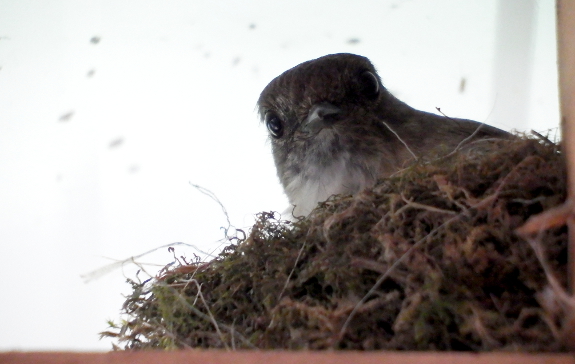
The wren made a home inside a cardboard box and the phoebe tucked her nest up under the eaves.
We haven't seen a single mosquito with four bug zappers on the job.
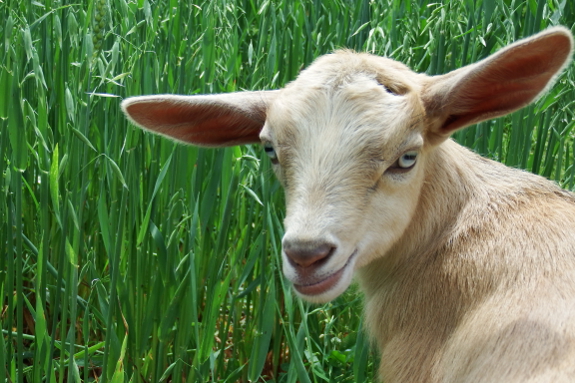
Our goat twins are three
weeks old, but they seem more like miniature adults! They're still
gorging on milk, but have been starting to nibble at greenery for the
last week or so.
This photo is Aurora, who's both much skinnier and much more adventuresome than her brother.
Sometimes I worry she's a little too skinny...then I figure he's
probably just a little too fat. After all, I watch Auorora drink and
feel her belly to make sure it's full every day, and she continues to
outpace her brother in overall body height and length. I think she got
more of the Nubian genes and he got more of the Nigerian.
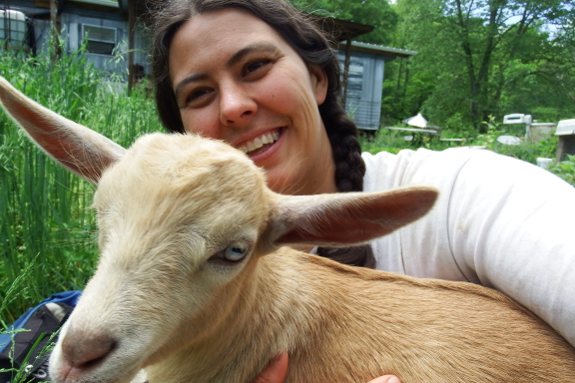
The other kid news of the week is that our little buckling has a name --- Punkin. Since his home will be on the Punkin Patch
farm and since his hair has an orangish cast, I think the name is
fitting. Here's hoping he'll learn to answer to it --- not that he does
anything I ask at the moment anyway.
Punkin is a major cuddler, always happiest when he's in my lap. But his
favorite game is bouncing on and off endlessly. Now that his hooves are
getting harder and his horns are starting to poke out of the skin, I'm
slowly turning the lap game rules into sit-still-and-shut-up, which he
complains about...but still begs for whenever I enter his space. Yes, he
does appear to have inherited the world's sweetest goat genes from his
mother (who deserves her own post, coming soon!).
Sugar snap flowers today will equal crunchy green salads in a few weeks.
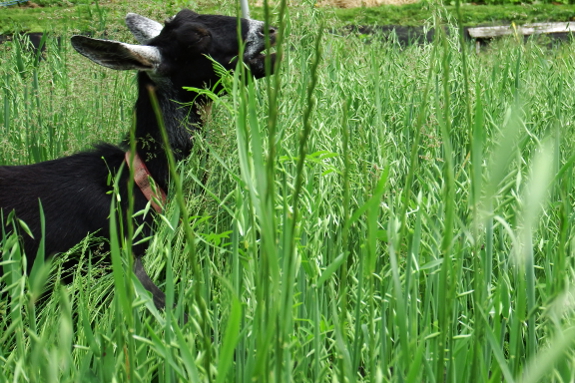
On Mother's Day,
Artemesia finally got the message --- she needs to fill her own belly
first. Okay, so she didn't entirely toe the line immediately. But she
started nibbling a bit of the cream of her pasture, was willing to eat
out in the world while I sat nearby with her kids, and even grazed for
up to half an hour in the forest when I shut the kids in the coop to
keep them out of both of our hair.
I'm ashamed to say that this last scenario is my favorite --- kids are
cute, but I vastly prefer the serenity of enjoying the outdoors with a
gentle adult goat. Artemesia, on the other hand, prefers option two ---
she's only fully content when her kids are accessible to her eagle eye.
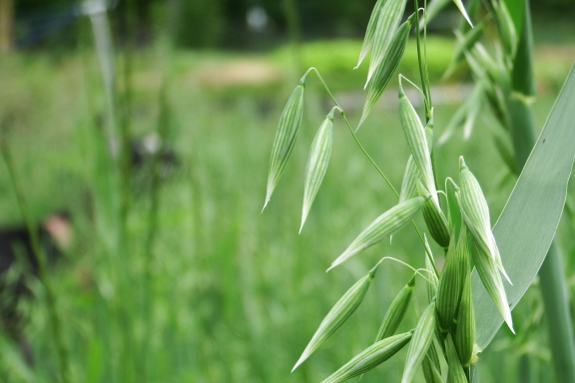
To please the crowd, I
usually take momma and babies out to nibble on oats at the bloom stage
for their morning/noon repast. These are the cover crops I planted into close-cut lawn last fall,
and the patch did an amazing job of feeding goats all winter in the
sunnier parts of the yard (while pretty much doing nothing in the
shadier parts of the yard). The goats kept the grains nibbled low enough
that they survived the winter in a vegetative state, and the plants are
now pushing up blooms...which apparently are the tastiest thing since
dried sweet corn.
Artemesia browses through
the patch at head height, eating nothing but the top six inches of
growth. Once she's done, I'll see if more tasty flowers pop up. If not,
I'll sprinkle soybean seeds into the standing grain then have Mark whack
the latter down to ground level. Come fall, I'll definitely plant this
area in oats once again. The amount of enjoyment and forage value we've
gotten out of $5 of cover-crop seeds is truly astounding.
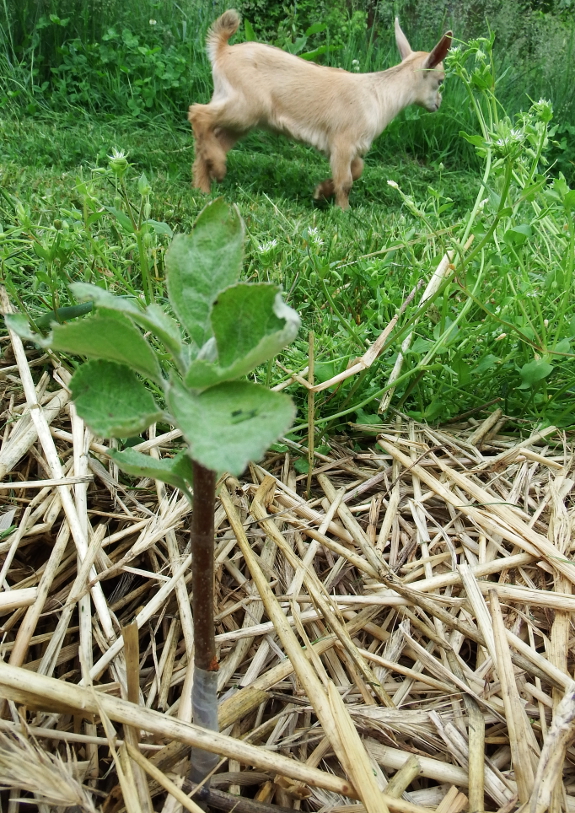
But the goat kids are growing faster.
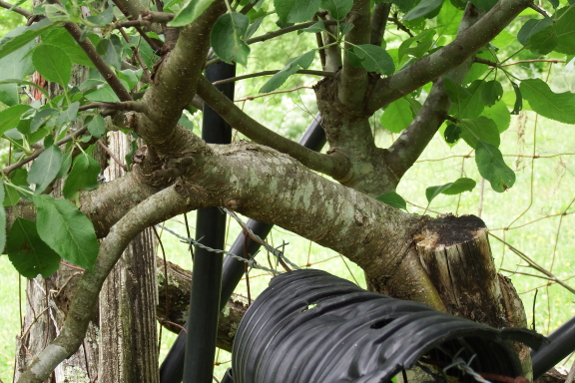
I went over to my movie-star neighbor's orchard Saturday, ostensibly to help him thin the fruits
but actually just to peruse his ingenuity. The oldest tree in the
orchard looks like it's about a decade old, and Frankie has grafted
different varieties onto several branches. The photo above, for example,
shows a limb that was cleft grafted maybe seven years ago.
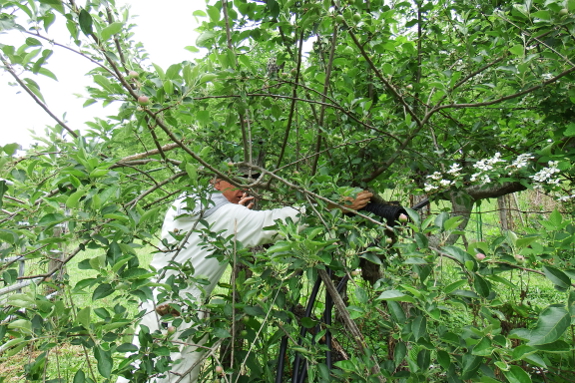
Here's the same limb from further afield. It's coated with tiny apples.
Another limb of the same
tree was grafted more like five years ago and is an interesting data
point. The parent of that particular scionwood is in the orchard nearby
and barely has half a dozen baby apples on it...but the branch on the
older tree is coated with a hefty crop of incipient fruits. In other
words, the maturity of the tree accelerated production of that branch,
something I've noticed in my own small experiments in that direction. So
if you want to try out lots of varieties fast, the best option is to
graft them onto branches of older trees rather than onto rootstock.
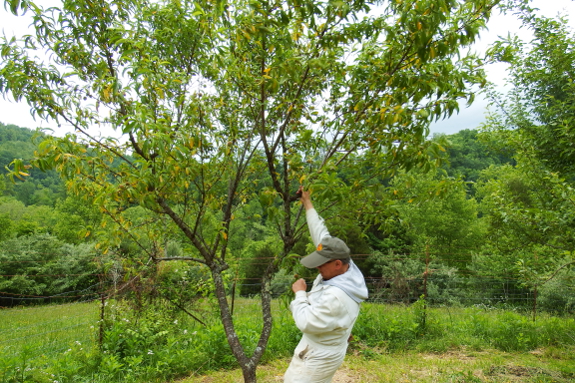
Finally, here's the best
option we came up with for thinning those peach branches way above our
heads --- give the tree a hard shake. Just don't look up!
We think we solved our kidding stall problem with this large and sturdy pet crate.
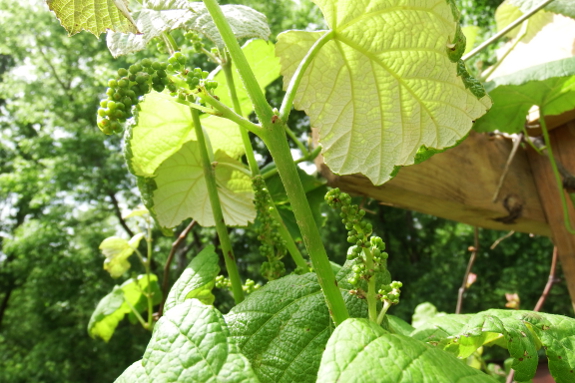
Winter coats (for us) and row covers (for the plants) came out one last time this weekend.
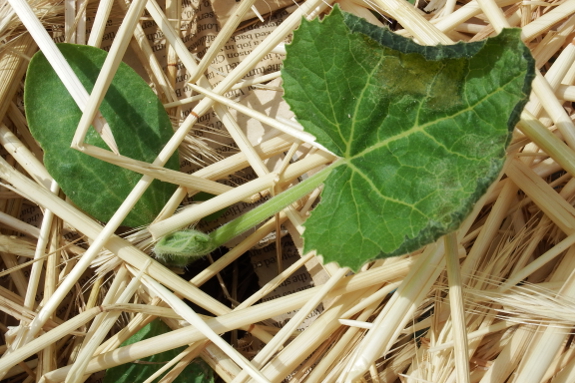
Forecast low --- 38.
Actual low --- 32. Luckily, damage was very minimal, mostly because the
frost was extremely short-lived and spotty. I could hear frozen dew
melting off the porch roof shortly after dawn as the outdoor temperature
rose above freezing. In the end, only a few leaves here and there were
impacted. (Yes, the squash plant above was under a row cover.)
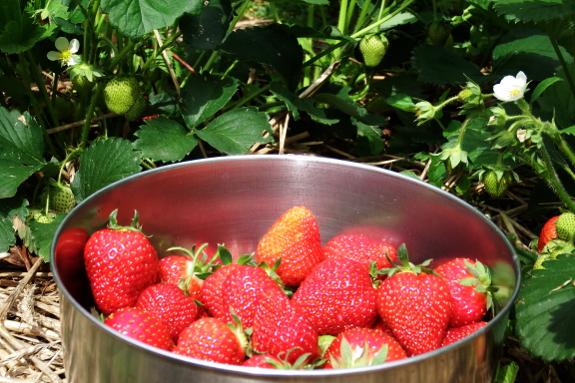
That had better be the last freeze, because it's time for these...
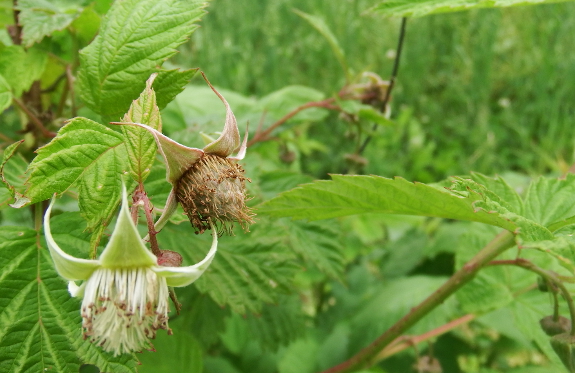
...And, soon, some of these. Hear that, winter --- it's time to relinquish your grasp and let summer have a go.
We installed a layer of plywood to the top of the crate to make it climbing friendly.
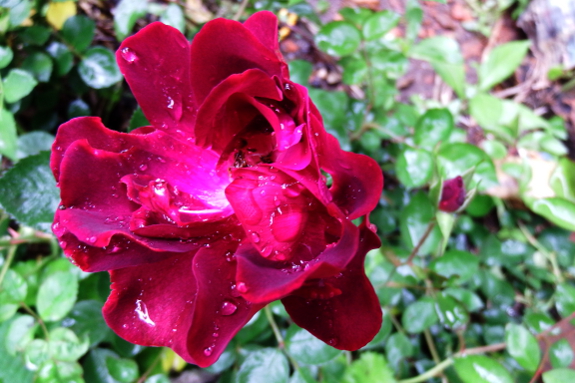
The best part about rain in a garden? Even if you're snug inside with a book, the flowers and vegetables are still growing.
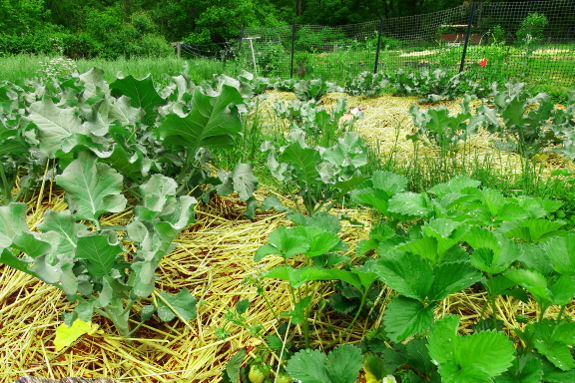
The worst part about rain in a garden? Even if you're snug inside with a book, the weeds are still growing.
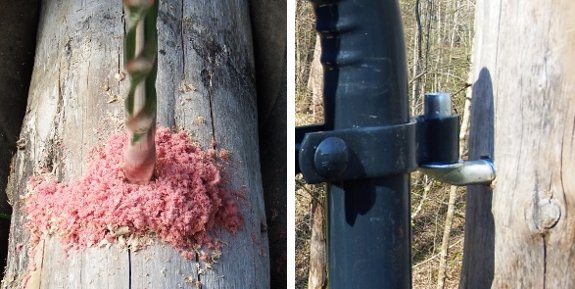
What makes our new
livestock gate easy to swing is the simple hinge design.
The large 5/8 inch drill bit
was too much for a battery powered drill.
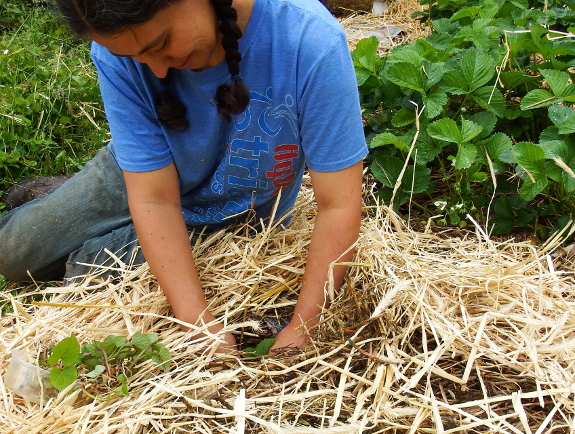
A drizzly day is perfect weather for setting out sweet potato slips.
This is almost the end of our summer transplants, but I do have a flat
of sunflower seedlings waiting in the wings. After I find them homes,
it's time to start all over by filling yet another flat with brussels
sprouts in preparation for the fall garden.
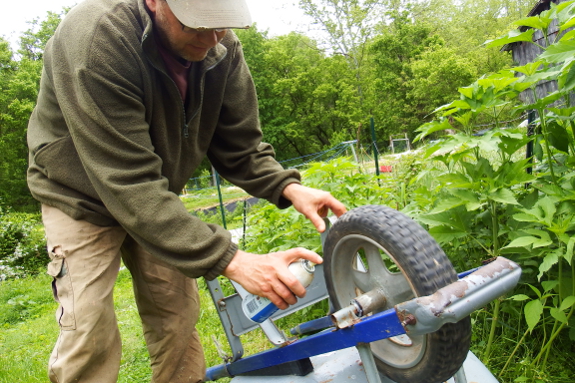
One application of lithium grease to a squeaky wheel lasts most of the year.
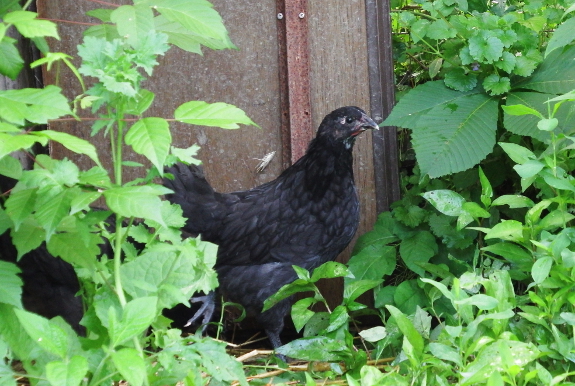
We usually move our
chicks from free ranging to fenced pastures when they're about a month
old. The transition isn't for their sakes but for mine --- older chicks
have a tendency to scratch up my mulch and peck up my strawberries.
This set of pullets preferred browsing the far edge of our yard beneath the pear trees rather than invading the garden. But at six weeks old, they'd dramatically outgrown their brooder. Off the coop it was to learn grownup perching!
The big thing we like about
the Swisher string mower is its
ability to mow heavy weeds without the danger of a metal blade hitting
something.
One of the downsides to its
awesome power is the way it throws weed pieces everywhere.
Our solution is to use the
old push mower on stuff near food we want to eat.
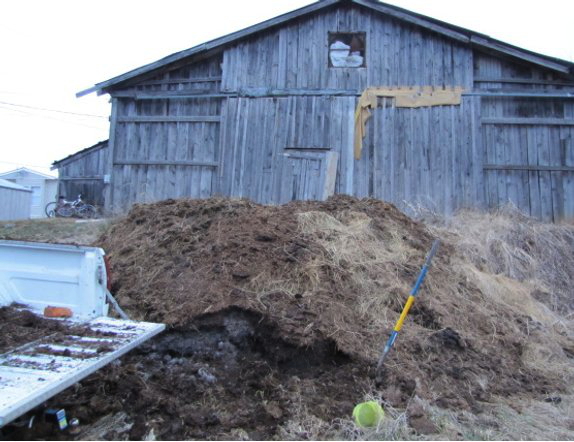
We used to get our compost at this massive horse-manure mother load.
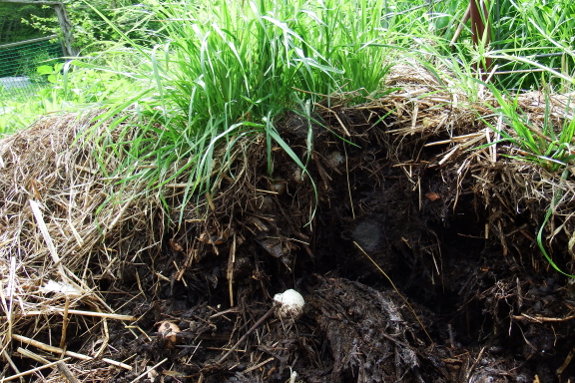
But I have to admit I
love this pile ten times more. Yes, after rotting down all winter, our
homegrown goat-poop pile is minuscule in comparison. Yet the compost is
located a short wheelbarrow journey away from our garden and I know
exactly what went into every shovelful. In fact, manure day is the only
time of the year when I wished I had twice as many goats.
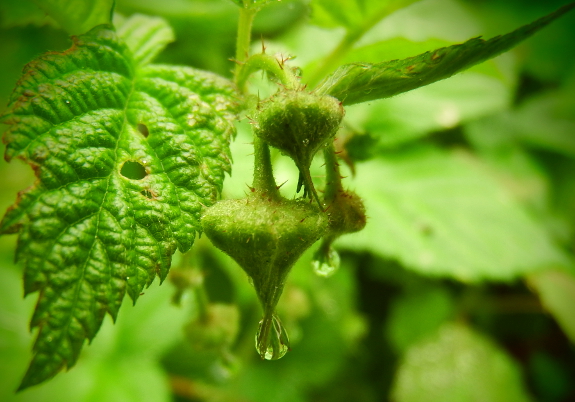
It's nice to know these raspberries will mature around the time our strawberries decide to give up for the year.
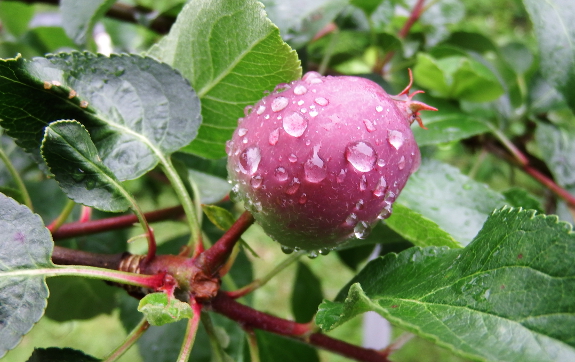
I've been spending a lot of time ogling my apple trees, watching the unexpected fruit swell under the summer sun. But everything isn't rosy in the mini-orchard.....
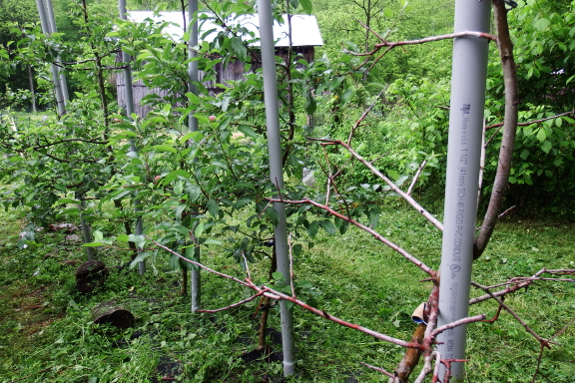
We had three tree deaths
this winter, all individuals who simply failed to leaf out as planned
when the cold weather broke. It's tempting to blame the losses on
variety. The specimen above (Pristine), for example, barely grew last
summer due to a terrible case of cedar-apple rust...even though its fellows just showed a few spotted leaves then shrugged off the fungal disease.
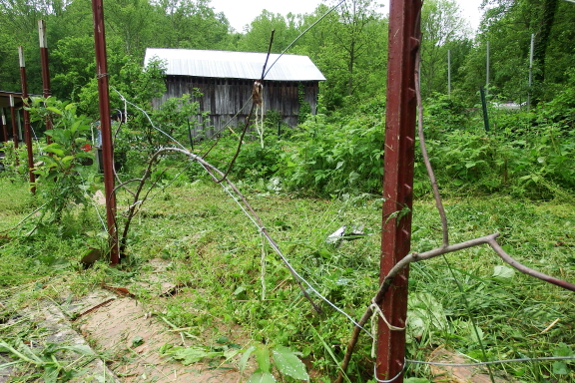
However, I'm now feeling
like the ultimate deciding factor in who thrived and who perished was
location. The two trees shown above, like the one in the previous photo,
are the individuals closest to our north-facing hillside. And they just
happen to be the only trees who perished among all eleven of the 2014
graftees. Hmmm.... I guess that permafreeze, high shade zone just isn't
fruit-tree friendly. Good to know, and good to learn on home-grafted trees that cost us no more than a buck apiece.
We added another metal trash can to our feed and seed storage system.
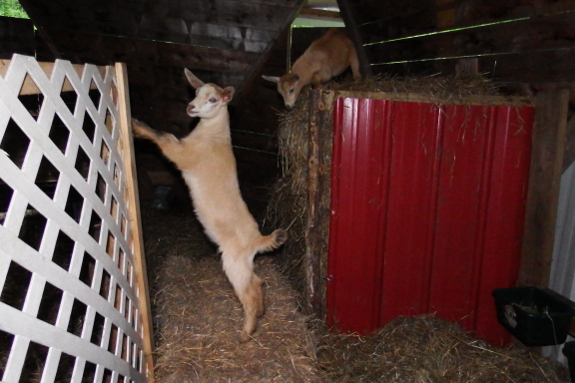
Although I milked
Artemesia for the kids' first two weeks of life, the youngsters quickly
grew big enough to take up that slack. Luckily, two weeks of age is also
when goatlings are old enough to be locked away for the night, giving
the human twelve hours of free milk.
The trouble, as Mark alluded to, was that our kidding stall is not impossible for a determined goat to access.
The first night I locked the kids in, I heard distressed crying for
about ten minutes...then everything went ominously quiet. Sure enough,
when I went up to check on the herd, Artemesia had jumped over the wall
to be with her babies. So I opened the gate and put on my thinking cap
for a solution.
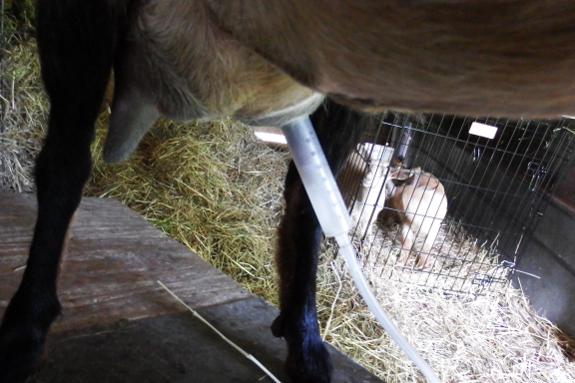
We could have bulked up
the walls and done our best to keep momma goat out. But I don't like
Artemesia to be in distress, and barely being able to see her kids
through the lattice gate was clearly too scary for her to handle.
Enter the dog kennel
shown here. It worked perfectly --- the twins were a little pissed at
not being able to get into mischief overnight, but Artemesia could lie
down right beside them and everyone was happy. In fact, our doe gets so
relaxed after not having kids crawling all over her for twelve hours,
that by day three I stopped locking her head in the stanchion during
milking time. With carrots in the hopper, Artemesia's quite content to
stand still and let the machine pull out her milk.
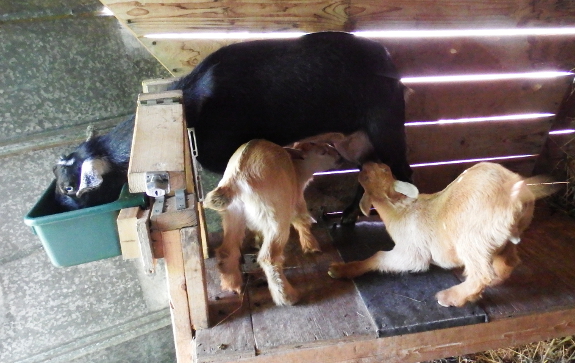
The kids are always
anxious to get their breakfast, but they wait semi-patiently until it's
their turn. Rather than hand-milking out the last cup or so, I just
release the barbarians and they stampede for the udder. Then I take my
two or three cups home with a smile --- happy goats make for a happy
human!

I've changed my mind about
this being the best
heavy duty gate latch.
The main bar will bend with
repeated ramming from a medium sized goat.
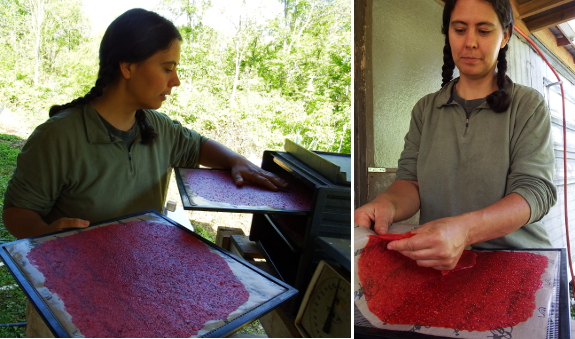
Strawberries are my
favorite fruit and fruit is my favorite food group. So you'd think I'd
be tempted by out-of-season berries at the grocery store.
The trouble is, homegrown
strawberries are so good I now turn up my nose at even the offerings
from the local berry farm. Instead, we gorge on delicious red fruits for
one month out of the year and we dry a little bit of leather for winter treats.
Since writing that linked-to post, we upgraded to an Excalibur dehydrator
to make it more feasible to dry food in our wet climate. But,
otherwise, our method of storing summer sunlight is very much the same.
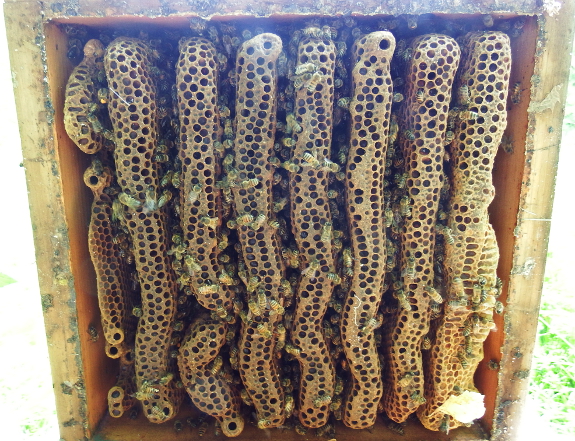
I hate to admit it, but I
got a bit disheartened by our bees and ignored them for a solid month.
The thing is, I actually lost track of how many swarms materialized and then flew away, never to be seen again. (Four, I think?) It was
pretty amazing when I was watching Artemesia and family graze in the
oats and a mass of bees came flying just over our heads, a few landing
on the trailer roof before leaping back into the air. But my rational
side knows that each absent swarm is that much less chance of homegrown
honey this year.
I seem to use lots of
20/20 hindsight with the bees, but here's a little more. When I opened
up our swarming hive in April, I saw lots of queen cells at the bottom
of the warre box. I cut off one...then got all worried. If the old
matriarch left and I removed all the queen cells, will the new hive
perish? So I left the rest in place. As you can see in the image above,
though, there were many more queen cells than were really necessary, the
likely source of so many afterswarms.
The other hive did
swarm too, though. That one had fewer queen cells in it (two or three, I
think), probably because there wasn't the gap between warre and
langstroth boxes that my converter top created. Honestly, I think that
feeding warre hives in the spring just makes them swarm. So if I want to
bulk up the hives early in search of honey, I need to hurry up and get
those bees back into langstroth boxes so I can checkerboard and use other swarm prevention techniques. (Warre frames just aren't movable enough to use techniques like this with success.)
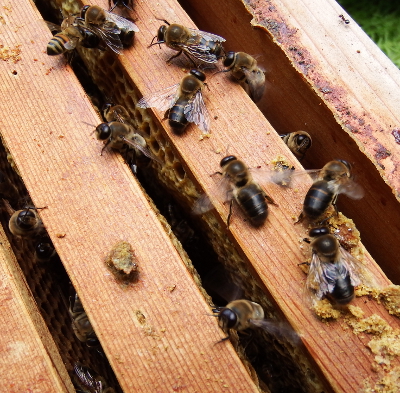 On
the plus side, the hive that swarmed several times has capped brood and
is bringing in lots of pollen. So, fingers crossed that their new queen
will finally start laying eggs in the langstroth boxes and I can remove
the warre box to complete the conversaion. The other hive swarmed a bit
later and is all warre (so harder to tell what's going on inside). But
they've got a good bit of honey and will hopefully have new workers soon.
On
the plus side, the hive that swarmed several times has capped brood and
is bringing in lots of pollen. So, fingers crossed that their new queen
will finally start laying eggs in the langstroth boxes and I can remove
the warre box to complete the conversaion. The other hive swarmed a bit
later and is all warre (so harder to tell what's going on inside). But
they've got a good bit of honey and will hopefully have new workers soon.
And, all things
considered, I don't regret being so engrossed in Artemesia's kidding and
in the twins' early childhood that I missed a heaping handful of
swarms. If I could go back in time, even knowing what I know now, I'd do
it all over again. But maybe next year the two events won't coincide
and I'll be a little smarter about early spring bee management. And, who
knows, it could still be such a good nectar year that we get honey.
Hope springs eternal....
It was a risk planting this sweet corn on April 20th but I think we're in the clear.
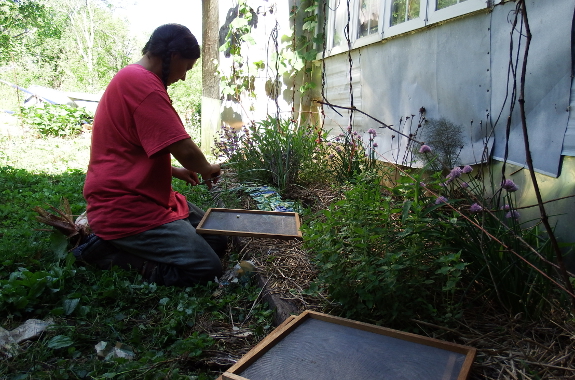
My little herb bed on the
south-facing side of the trailer is doing beautifully this year. On the
recommendation of one of our readers, I started some Greek oregano from seed
last year and found to my delight that it did indeed have much more of
the flavor I was looking for than the plain old oregano I'd grown
before. Throw in some sage, lavender, thyme, chamomile, fennel, chives,
and a few flowers and I have a pretty and delicious space right outside
the back door.
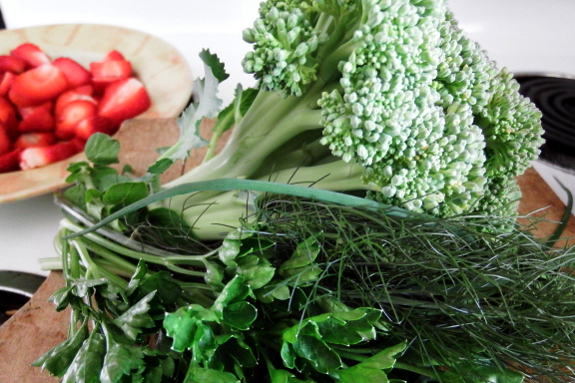
Being so close to the
kitchen, the herb garden reminds me to pick a little flavor for meals
that I might otherwise skip. I'm also air-drying a few of the more
aromatic leaves while they're at their peak since last year's dried basil really hit the spot over the winter.
Mostly, though, I'm just enjoying the low-work, high-reward growing space. There's nothing quite like zone 0.5 homesteading projects that really work.
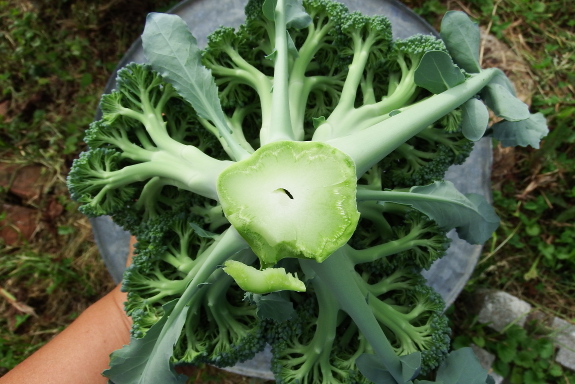
What's the first thing
you look at when you pick a head of broccoli out of your garden?
Personally, I flip the whole thing over and search for signs of cabbage worms. This year, each head I've harvested has been pristine.
What's the secret?
Starting the plants early so they bulk up before butterfly season is in
full swing. (Yes, the cabbage "moth" is really a butterfly.) I cover
this and other permaculture tactics for dealing with pest invertebrates
without chemicals in The Naturally Bug-Free Garden. Here's hoping your broccoli is just as sweet and caterpillar-free as ours have been this spring.
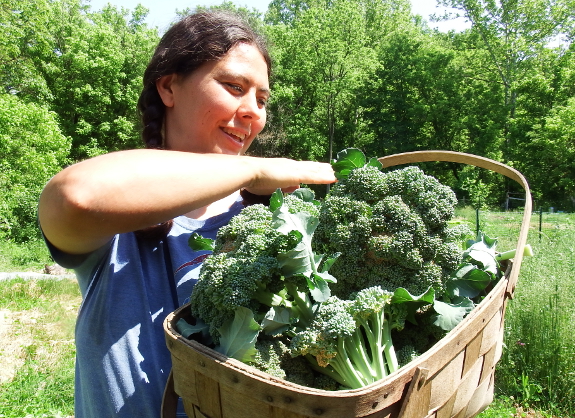
Fourteen pints of broccoli is twice as much as we froze in all of 2015.
Even better, two-thirds of the crop is still in the garden.
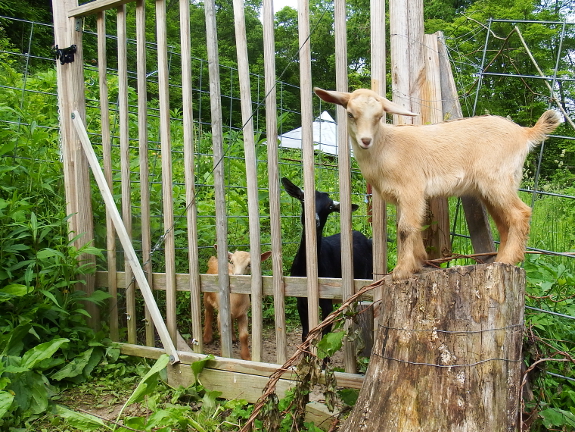
Okay, I never said they were all on the same side of the gate.
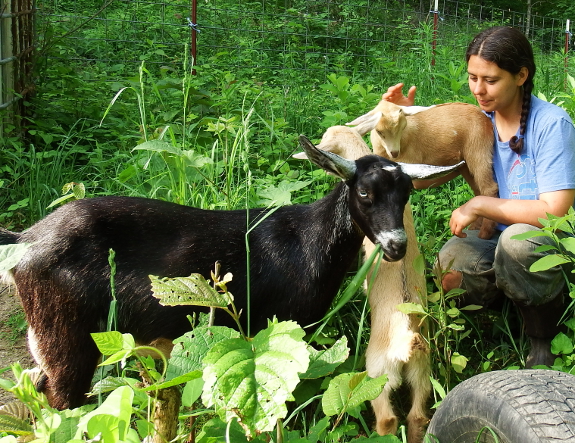
More seriously, there's
been some trouble in paradise over the last few weeks --- hoof rot. As
these things go, I suspect it's a very light case, but the recessed hoof
area freaked me out enough to order some zinc sulfate
to stop the bad bugs in their tracks. While I was waiting for the drug
to arrive, I also instituted once-a-week hoof trimming, which Artemesia
submitted to with her usual "please don't...but okay if you must" grace.
Interestingly, by the time the Hoof-n-Heel came in the mail, her
problematic hoof area was already starting to regrow.
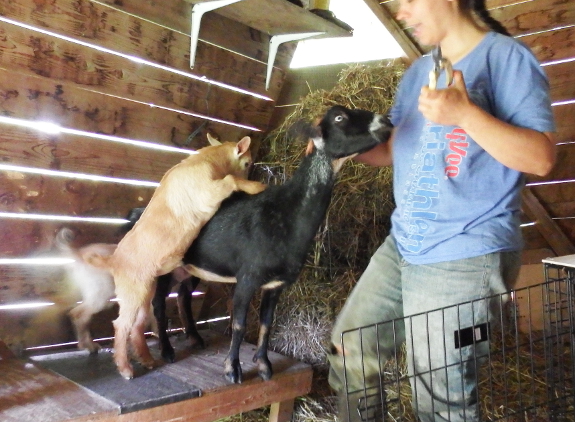
I suspect the root of the
problem was threefold. First, Abigail was a bully and often didn't
allow Artemesia to stand up out of the mud on the loafing stations...even though we put two porches in the pasture to ensure there was enough space. Yes, our ex-herd queen would run back and forth chasing Artemesia away from anything tantalizing just for the fun of it.
Second, the threadworms that popped up in Artmesia's fecal matter were a warning sign I should have paid more attention to. I did
read that threadworms can cause hoof rot as well as being an intestinal
parasite but I ignored that issue since our goats' feet have always
been top notch.
Finally, I skipped
hoof-trimming during Artemesia's last month of pregnancy because she
really wasn't in the mood. But a slight jostling of her kids would have
been worth nipping the hoof rot in the bud.
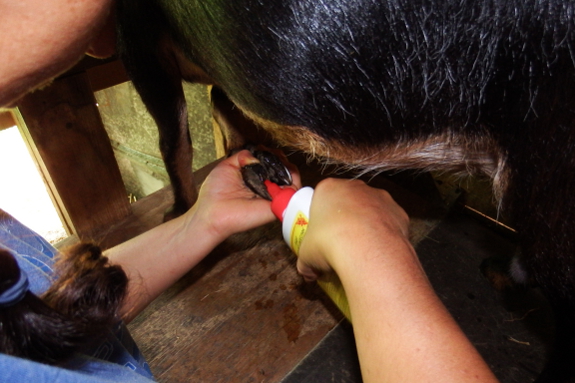
All of that said, it's
not the end of the world. I'll keep treating the problematic front
hooves daily with the zinc sulfate and trimming weekly until all signs
are gone, and I've also rotated to a new pasture in hopes of keeping our
doe off wormy ground.
Now that Artemesia is back eating lots of greenery, her overall health
has improved so much that she might have been able to fight off the
problem on her own. And even the weather is cooperating, turning hot and
dry. So hopefully our darling goat will be back at 100% in short order.
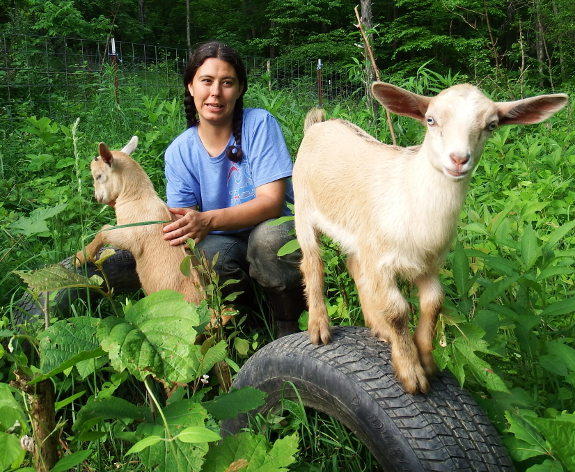
Oh and here's one last
cute-goat photo to make up for regaling you with such a difficult topic
today. Our goat kids really might be growing faster than the weeds!
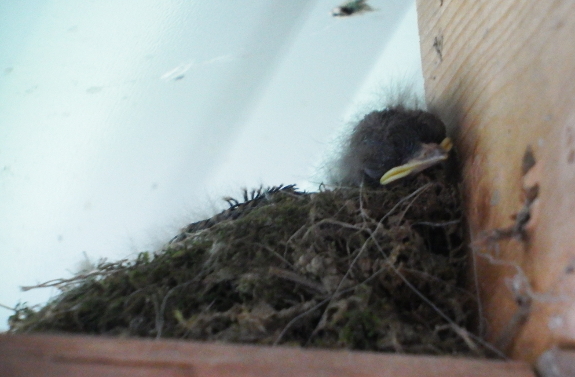
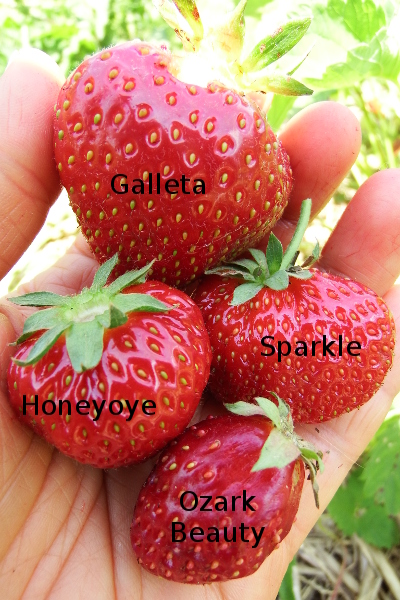 Disease-resistance, date of
bearing, and size of berries are all relevant factors for the organic
strawberry grower to consider. But if I'm being honest, I'll tell you
that I make variety selections based 95% on taste.
Disease-resistance, date of
bearing, and size of berries are all relevant factors for the organic
strawberry grower to consider. But if I'm being honest, I'll tell you
that I make variety selections based 95% on taste.
With that in mind, we've ripped out multiple varieties that just didn't
make the cut. Fresca, Jewel, and Allstar simply weren't tasty enough
for my palate.
At the other extreme, delectable keepers have included:
- Honeyoye --- a big berry with a more subtle (and slightly sourer) flavor than most. On the downside, this variety is prone to diseases, and those diseases accentuate the sour. But an undiseased, sunkissed Honeyoe is a delight!
- Ozark Beauty --- a small
but ultra-sweet berry that melts in your mouth. I snack on these the
most when I'm out and about in the garden because they're just so
dependably good. On the downside, I'm not 100% sure the plants actually
are that variety since I bought them at Wal-mart and the big box stores
are notorious for mislabeling edibles, so you might not get the same
results I have....
- Sparkle --- this
late-fruiting variety is like Ozark Beauty on steroids. Some fruits are
small, but many are big, all are sweet, and they are actually too soft for some applications.
These plants benefit from daily rather than my usual bidaily picking
and I'll admit that a few end up rotting on the vine.
- Galletta --- this
ultra-early variety lost most of its blooms this year to freezes.
Perhaps that's why the berries that did set are humongous rather than
small as I'd understood they'd be? They're also quite firm --- nearly
the consistency of storebought --- but are almost as sweet as Ozark
Beauty and feature a hint of Honeyoye's tartness. I find myself
snacking on these almost as much as on Ozark Beauty.
How about you? Which strawberry varieties have turned you into a fruit
connoisseur?
Our old hand me down garlic press broke recently.
We've been using this fancy stainless steel garlic press for the last two months.
It's a lot easier to clean and seems like a more solid design than the old one.
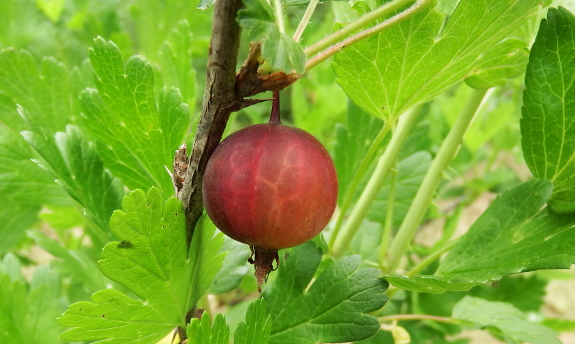
French psychologist
Erika Apfelbaum once said, "Americans eat with their eyes." The sheer
quantity of wasted produce in our food system proves that she is,
unfortunately, correct.
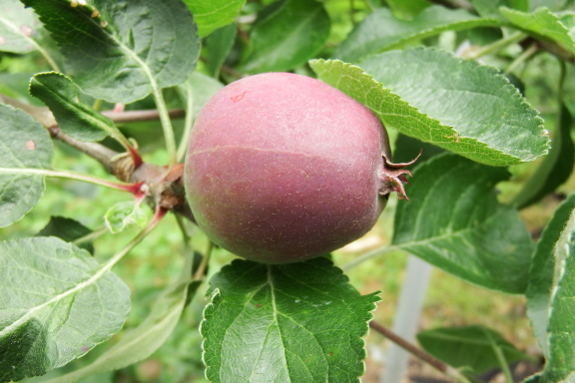
However, I have to admit
that as a gardener I totally eat with my eyes. Only I do so long before
the food in question is ripe.
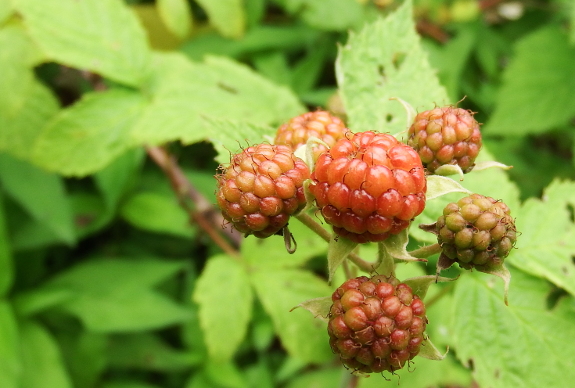
For example, in the
making of this post, I consumed a delectable gooseberry, half a dozen
apples of various flavors, and a handful of raspberries (both red and
black). I'm stuffed!
Today was that one day of the year where we harvest garlic scapes for lunch.
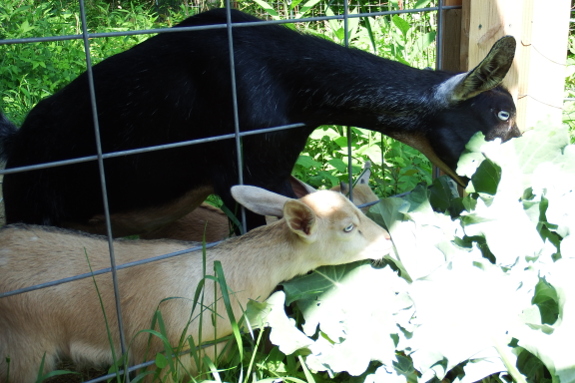
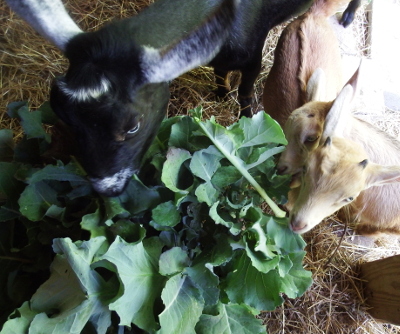 My garden layout revolves far
too much around the goats.
My garden layout revolves far
too much around the goats.
"Hmm, what can I plant
in this open bed?" I wonder. "How about some field corn and sweet
potatoes to boost Artemesia's milk production?"
Or, Monday morning: "I
wonder where I can find a spot to grow sweet corn? Well, if I feed
these used-up broccoli plants to the herd, our summer crops can slip in
right there."
The trouble is, goats
are just so appreciative. Artemesia and company told
me they enjoyed their broccoli bouquet very much...so I'll probably
repeat the endeavor today. I'll just have to freeze
another load of broccoli first....
Want more in-depth information? Browse through our books.
Or explore more posts by date or by subject.
About us: Anna Hess and Mark Hamilton spent over a decade living self-sufficiently in the mountains of Virginia before moving north to start over from scratch in the foothills of Ohio. They've experimented with permaculture, no-till gardening, trailersteading, home-based microbusinesses and much more, writing about their adventures in both blogs and books.
